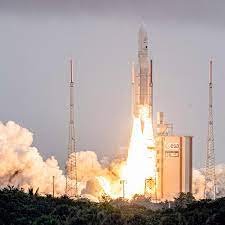The James Webb Space Telescope: What does it do?
Imagine a super-powered telescope that can see into the depths of space with incredible clarity and precision. That's exactly what the James Webb Space Telescope, or in short, JWST is all about. Named after the important figure James E Webb for his role in space exploration, the JWST is a cutting-edge piece of technology that will further our understanding of the cosmos.
If we want to learn more about the space telescope, we need to look at the person it’s named after, James Webb.
James E. Webb was born on October 7th, 1906, in the state of North Carolina. He attended college at the University of North Carolina, and became a secretary for the US representative Edward W Pou. He served in the marines, joined world war 2, and eventually became a undersecretary of state in the US Department of state. After this eventful career, in 1952, he retired because of intense migraines.
Nine years later, in 1961, President John F. Kennedy elected Webb as the administrator of NASA, also known as the National Aeronautics and Space Administration. During his NASA administration, he helped with the moon landing, the Johnson Space Center, and even fought for civil rights and brought racial diversity to NASA.
After all of these accomplishments, he retired in 1981, and died from a heart attack on March 27th, 1992. Because of his accomplishments to The United States, NASA, and to space exploration overall, a new space telescope known as the Next Generation Space Telescope was renamed to the James Webb Space Telescope to honor him.
Now that we know why the telescope is named James Webb, and where the name comes from, we can look at the telescope itself.
The James Webb space telescope was made to be exactly what its former name implied. It was set to be a next generation space telescope, a leap into the next generation of space exploration.
”Launched in December 2021, the James Webb Space Telescope is the successor to the Hubble Space Telescope, which was launched in 1990.” said Riley Teacher Mr. Buison. “It provides a glimpse of the early objects of the universe, including stars and possibly habitable planets in systems and galaxies light-years away.”
Bigger and better than any telescope before it, the James Webb has a massive mirror that's more than twice the size of the Hubble Space Telescope, the most powerful space telescope prior to James Webb. This increased size means it can capture incredibly detailed images of distant stars, galaxies, and planets.
To get the best view, the James Webb will be positioned about 1.5 million kilometers away from Earth, even away from the moon. It will be shielded from the Sun's heat by a special shield, which keeps it from burning apart or freezing in the cold of space. This distance from Earth and protection against harsh temperatures is important because it allows the telescope to detect some of the furthest things in the observable universe.
One of the main goals of James Webb is to study the history of the universe. By observing ancient galaxies and celestial objects that formed shortly after the Big Bang, scientists hope to learn more about how our universe came to be, and they’ve already gotten close to that goal just with their very first capture.
This picture shows the first capture James Webb had. Now you may be wondering, why is this picture so significant? That is because it’s a picture of the past. A picture of the early universe, about 13.5 billion years ago.
Taking pictures of the past sounds ridiculous, but it’s true. Light travels across the cosmos very slowly, so what you see isn’t accurate to the moment. If you look at the stars at night, everything you see isn’t currently there, it’s most likely 1000’s of years old. The reason you see it is because it’s simply the light from the past reaching you.
This slow passage of light is exactly what James Webb used to get these early, extravagant pictures of the early universe. If you want to learn more about how we're constantly looking at the past, I'd suggest reading this article.
But James Webb doesn't stop there. It will also help us study exoplanets, which are planets that orbit stars outside our solar system. By examining the atmospheres of these distant worlds, scientists can look for signs of life and determine if they could be habitable.
Equipped with advanced equipment, the James Webb will give scientists an unprecedented view of the universe. It's the result of collaboration between NASA, the European Space Agency, and the Canadian Space Agency, showcasing the power of unity between nations.
“If you want to learn more about the space telescope, you should go to NASA’s website.” Said Senior Cameron Connett.
With all this information out of the way, you now know all about the James Webb, and you can sit back as the James Webb Space Telescope informs us more about the cosmos.
If you have any questions, comments, or criticisms, feel free to email me.


